Round Table Discussion: Five Former Nisei Week Queens

We sat down with five former Nisei Week Queens from a span of several generations for a round table discussion about their roles in the Japanese American community, among others. Chizuko Judy Sugita de Queiroz (1953), Helen Funai Erickson (1963), Sandy Toshiyuki (1976), Tracy Isawa Ahn (1983), and Erika Mariko Olsen (2011) shared stories with us that offer insight into the motives of the community as well as the changing role of women in Little Tokyo. Hear them in the videos above.
The Great Depression had brought economic hardships to the Japanese-owned businesses in Little Tokyo. But the greater concern was the increased disinterest of the nisei -- the first American-born generation of Japanese -- who were straying away from the tight-knit community of their parents.
Nisei youth, while Japanese by heritage, were American, and their interests aligned more closely with their nationality rather than with their Japanese-born elders. At the time Little Tokyo was home to over 30,000 Japanese -- then the largest concentration in the U.S. -- who provided stability for the business district that catered exclusively to their needs. But Little Tokyo needed the patronage of the nisei to survive the latter half of the 20th century.
Urged by support from the issei merchants in Little Tokyo, spirited nisei organized the first Nisei Week Festival in 1934 as a marketing strategy to celebrate the achievements of the community and bring in outside shoppers to the struggling businesses in the area. The week-long event included a parade, talent show, traditional folk dance and its highlight -- the crowing of the Nisei Week Queen.
The Nisei Week Festival served as way to control the image of Japanese Americans, who were merging into the general society despite the prejudice and denial of identity they faced even as U.S. citizens. The festival displayed examples of hybridity between Japanese and American cultures, and the Nisei Week Queen -- ready for any occasion in a kimono or evening gown -- embodied what the community wished represented of them.
Organizers of the festival decided to have a queen over a king to mark a clear distinction from the male-centric gender values favored in Japan at the turn of the century. Akin to the responsibilities of a historical monarch, the Nisei Week Queen faced great responsibilities as a liaison for the Japanese American community in a year-long campaign to improve Little Tokyo businesses.
Today, the festival and the role of the Nisei Week Queen is more important than ever. The distinct culture of Japanese Americans continues to fade due to their assimilation into the general American public. Many areas outside of Little Tokyo now vie for their patronage, and the dominance of the Japanese in Little Tokyo has all but disappeared, leaving the fifth generation, or gosei, reason to disconnect from the community.
Yet Nisei Week continues. The Nisei Week Queen has morphed from a beauty icon to a powerful representative of her community, trained in public speaking, civic mindedness, and cultural history. Joining her in the year-long duties is her court, which represents the expanded Japanese American communities across Southern California. Former queens, now numbering 72, foster sisterly bonds built through their shared experiences, and they reunite each year during the festival. They come from their homes and far away places to share their stories with one another and volunteer their time to the festival, continuing their lifelong duties to the community -- a Nisei Week Queen will always be a Nisei Week Queen to Little Tokyo.
Just as the nisei pioneers who developed the festival deployed their talents to ensure the future of Little Tokyo, the teachers, artists, journalists, scientists, athletes and more who call themselves former Nisei Week Queens are pulling together to do their part for the future of Little Tokyo, which is always on the next generation's mind.
SLIDESHOW: Here's a photographic look back at past Queens, and how their roles have changed over the years.


